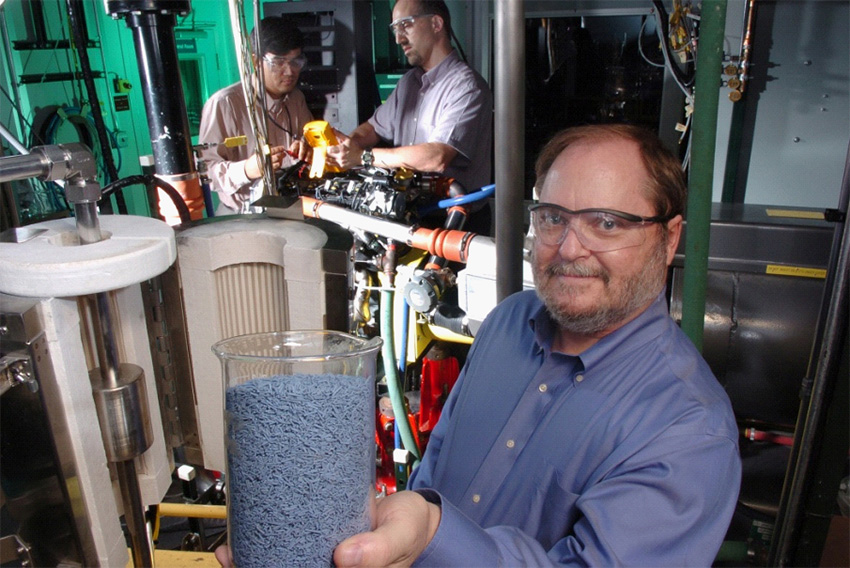Attenuating Diesel Engine Emissions
Photo courtesy of Argonne National Laboratory
Argonne chemist Chris Marshall displays a container of the diesel DeNOx catalyst, while Argonne researchers prepare to test it.
NOx emissions represent one of a handful of the most abundant greenhouse gases that pollute our atmosphere. Because the majority of America’s trucks – over 11 million vehicles in all – burn diesel fuel, this new catalyst can dramatically reduce emissions that impact our environment.
Why it Matters
The development of this catalyst offers a unique advantage over other methods of limiting NOx emissions—i.e., drivers do not need to add secondary fluids into a different tank to promote NOx reduction (because the diesel fuel added to the exhaust serves that purpose), and trucks do not need to be outfitted with complicated engineering controls. The catalyst lasts for more than 400,000 vehicle miles and requires minimal space on the truck body. The materials that form the catalyst are inexpensive and safe.
Methods
The diesel DeNOx catalyst is a coating that is applied to a porous ceramic brick, similar to a catalytic converter, which is installed in a vehicle’s emissions system. The technology works in conjunction with the particulate matter trap filter, which removes soot from diesel exhaust and is then processed by the diesel DeNOx catalyst to remove NOx from the exhaust stream.
By introducing fresh diesel fuel into the exhaust stream, the catalyst achieves high rates of conversion because of its interactions with the fuel’s hydrocarbons. The catalyst within the ceramic matrix actually helps the diesel fuel convert NOx to molecular nitrogen, a stable, generally harmless compound that composes about 78% of the earth’s atmosphere.
What’s Next
The catalyst can be retrofitted for installation on existing diesel engine vehicles, and a number of diesel-vehicle producers have expressed interest in the Argonne technology.
Argonne has initiated a licensing agreement between Argonne and a start-up company in Washington State. Future plans are to integrate the technology – named the diesel DeNOx catalyst – into the firm’s existing products that reduce emissions of greenhouse gases, according to the firm’s president. The products could be sold to original equipment manufacturers.
Acknowledgments
This work was led by Argonne chemist Chris Marshall, along with researchers Sundar Krishnan and Steve Ciatti.
Publications
“New Diesel DeNOx catalyst to reduce emissions by 95%.”
O’Dell J. 2008. “Argonne Labs Licenses Inexpensive New Diesel NOx Catalyst for Commercial Use.” Edmunds AutoObserver online. July 1.



